Runaway Train
Being on the back of a bolting horse is like being on a runaway train—you’re at the mercy of a big, powerful entity that you have no control of. Horses bolt for a number of reasons: they get spooked, they’re barn sour, they’ve found it’s a way to get out of work, etc. Some horses have figured out that if they bolt, their riders will do a One Rein Stop and they get to rest. Horses that are cold-blooded and lazy are quick to pick up on what gets them out of work.
One Rein for Control
If you find yourself on the back of a bolting horse, it’s just as important to know what not to do as it is to know how to safely handle the situation. When most people are on a runaway horse, they panic and pull back on two reins to try to stop the horse. At the same time, their entire body tightens up and they squeeze the horse’s sides with their legs. Curling up into this fetal position only makes the horse feel trapped and claustrophobic. The horse is already using the reactive side of his brain, and when the rider grabs on to him in this manner, it very much resembles a predator leaping on his back and digging his claws in.
As a prey animal, the horse has a flight or fight response, and when his ability to run is taken away from him, he’ll do whatever he can to survive the situation by bucking, rearing, kicking out, etc. What most people don’t realize is that they have better control of a panicked or out-of-control horse with just one rein. In fact, I have a saying I tell people to remember: One rein for softness and control; two reins to get killed. Why use one rein instead of two to control a horse? Using two reins makes a horse feel trapped, and it’s very easy for him to get leverage by lifting his head and neck up and pushing against the rein pressure you have on his face. With just one rein, you can make the horse bend his head and neck laterally, causing him to yield his hindquarters.
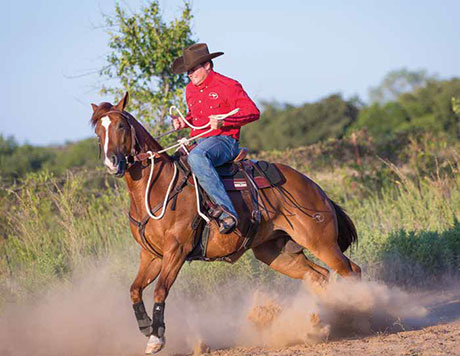
The worst thing you can do on a horse that is using the reactive side of his brain is to pull back on two reins and curl up into the fetal position. That only makes the horse more reactive and frightened.
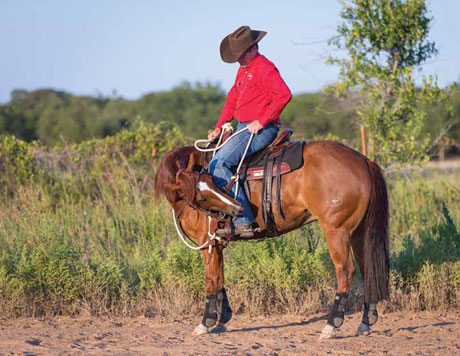
Because you never know what will happen on the trail, it’s important that executing a One Rein Stop be second nature to you and your horse.
If you teach your horse how to properly do a One Rein Stop, you’ll always have control of him and be able to prevent a dangerous situation before it happens. You should be able to flex your horse’s nose to your toe, have him stop moving his feet and soften from the walk, trot and lope. Anytime a horse disengages his hindquarters, his gas pedal and balance are immediately taken away from him. It’s like pushing in the clutch of a car. Without a gas pedal, he can’t go anywhere, and without balance, he can’t rear or buck.
I refer to the One Rein Stop as an emergency handbrake because anytime you feel unsafe or out of control, you can slide your hand down one rein, causing the horse to yield his hindquarters and stop immediately. Horses don’t like being scared, so when you’re in control and give them leadership, you’ll be amazed at how fast they’ll start to relax in any situation. However, in order for the One Rein Stop to work effectively, you have to prepare and teach your horse how to react when you sit back in the saddle and slide your hand down the rein. Otherwise, when he’s panicked and running from a perceived danger, he’ll get confused and panic more when you pick up on the rein. Sliding your hand down one rein to stop the horse has to be second nature to you as well. When an emergency situation occurs, you can’t stop and think about what to do—sliding your hand down one rein to stop the horse has to be an ingrained habit. The only way that happens is by practicing it over and over and over again.
If a horse is flat out galloping, you’ll have to spiral the horse down in a tighter and tighter circle until he eventually stops. Because he’s going so fast, pulling abruptly on one rein could throw him off balance and it’ll take longer to get his feet to stop. The secret there, though, is to not let the horse build his speed up to 90 miles an hour and then worry about how you’re going to stop him. Shut him down before he gets out of control.
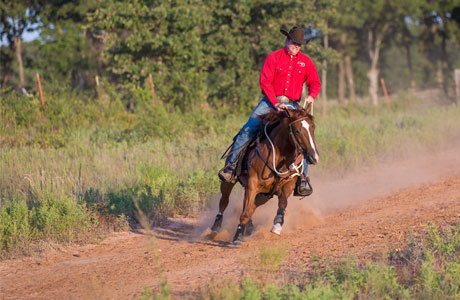
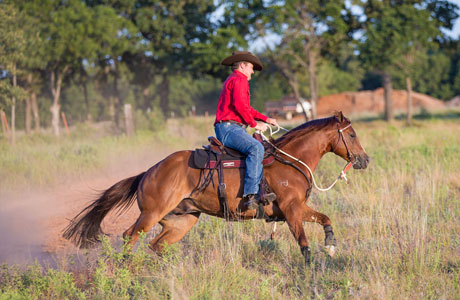
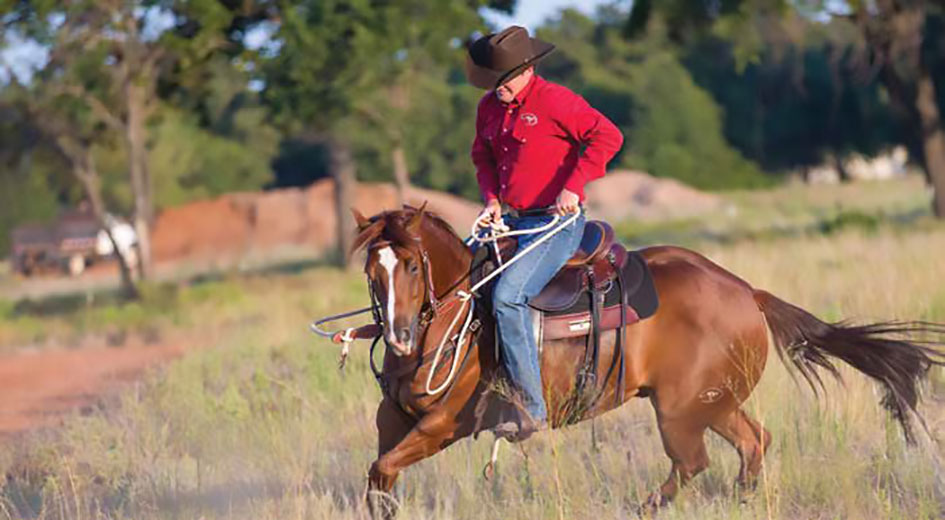
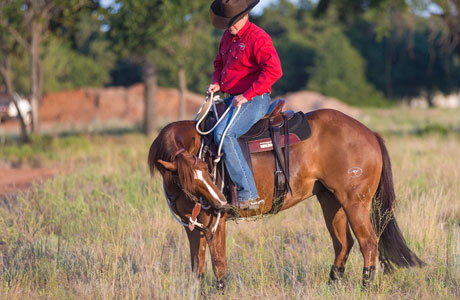
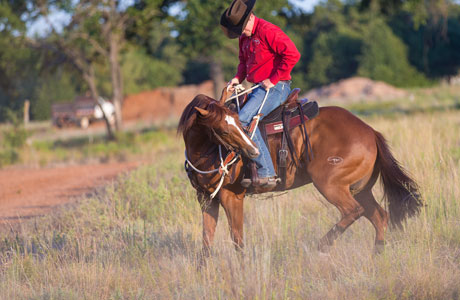
If your horse is galloping out of control, you’ll have to spiral him down to a One Rein Stop. You’ll use one rein to direct him into a tighter and tighter circle until he eventually stops.
Hustle Those Feet
Once you’re back in control of the horse after doing a One Rein Stop, put the horse’s feet to work. And I mean you need to make him hustle, constantly moving his feet forwards, backwards, left and right. Trot him in serpentines, do rollbacks, lope circles, etc. What you do isn’t important; it’s just important to hustle his feet and make him constantly change directions. Those two things will force the horse to use the thinking side of his brain and focus on you.
Then, after about 10 minutes of making his feet hustle, walk him down the trail on a loose rein. Dare him to take off again. If he breaks into a gait faster than a walk, immediately shut him down with a One Rein Stop, and then put his feet to work. Make him realize that bolting just results in more work. After a few repetitions of having to hustle and sweat, he won’t want any part of taking off on you. This fix will not work if you’re not assertive and do not make the horse hustle his feet like his life depends on it. If you bend him around in a few cutesy, cutesy circles, you’ll be wasting your time and teaching your horse nothing.
This correction will also not work if you give the horse any rest. Don’t do a One Rein Stop, sit on the horse and cry for 10 minutes while you sort out your feelings, and then put his feet to work. Put him to work as soon as you feel like you’ve got him under control again. In fact, if you don’t feel like you have to, don’t even bring him all the way down to a standstill. Pull on one rein until you’ve slowed him down enough so that you don’t feel in danger, and immediately go put him to work. The less downtime you give the horse, the better.

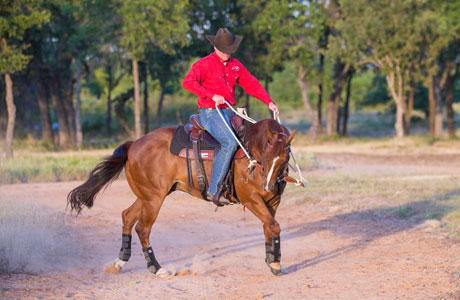
When you’re back in control of the situation, put the horse’s feet to work. I’m practicing serpentines here. The more you can make the horse change directions and hustle his feet, the faster he’ll tune in to you and use the thinking side of his brain.
Pick the Safest Option
If, once you get the horse stopped with one rein, you do not feel confident handling the situation from the saddle, there’s nothing wrong with that. You can just as easily hustle his feet from the ground to get him to use the thinking side of his brain. Lunging for Respect Stage Two is a great exercise to do in this situation. Remember, there’s never any shame in getting off your horse and fixing him from the ground. A great horseman finds the solution to a problem by keeping his and his horse’s safety foremost in mind. Just like my mentor Ian Francis told me: There are a lot of heroes in the graveyard. Too many people let their egos get in the way and end up getting bucked off their horses. You have one body, so take care of it. You can’t train the horse if you’re dead. The worst possible thing you could do is have the horse bolt and then get off him and take him back to the barn and put him back in his stall. Then the horse starts to think that bolting is the answer to getting out of work. You’d be surprised how quickly horses, especially the lazier ones, pick up on things like that. That’s why it’s so important to put the horse’s feet to work and show him that running off only results in more work, not less.
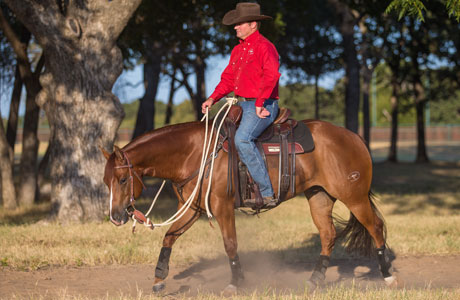
After hustling the horse’s feet for 10 minutes or so, if you feel that he’s relaxed and focused on you, put him on a loose rein and go down the trail. Dare him to make the mistake again.

You can just as easily hustle the horse’s feet from the ground as you can from the saddle. Lunging for Respect Stage Two is a great exercise to get the horse to use the thinking side of his brain.
Check In
One of the best ways to deter a horse from bolting or doing any other dangerous behavior on the trail is to check in with him every once in a while by asking him to move his feet and soften his body. As you’re walking down the trail, ask him to two-track or sidepass. Do a bending transition. Draw him to a stop. Keep him tuned in to you and on his toes.
I’m not saying you can’t ever put him on a loose rein, but every so often, you need to put his feet to work and get him to check back in with you. If you only ride your horse on autopilot, letting him go down the trail on a loose rein, he’ll find something to do with his energy and I can guarantee that whatever he finds to do won’t be your idea of a good time.
The bottom line, though, is that if your horse is truly bolting with you on the trail, you’ve done a horrible job of teaching him the Fundamentals. After taking your horse through the Fundamentals groundwork and riding exercises, you should have enough control of his feet and have earned his respect to the point that bolting is never an issue. If it is, he’s telling you that you’ve got a hole somewhere. You need to go back and figure out where it is.

Master Your horsemanship Skills
Like these tips? Join the No Worries Club and hone your skills with thousands of hours of Clinton’s easy, step-by-step method horse training videos.



